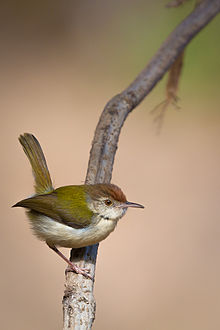Common tailorbird
| Common tailorbird | |
|---|---|
 |
|
| Foraging tailorbird in Sinhagad Valley | |
| Scientific classification | |
| Kingdom: | Animalia |
| Phylum: | Chordata |
| Class: | Aves |
| Order: | Passeriformes |
| Family: | Cisticolidae |
| Genus: | Orthotomus |
| Species: | O. sutorius |
| Binomial name | |
|
Orthotomus sutorius (Pennant, 1769) |
|
| Subspecies | |
The common tailorbird (Orthotomus sutorius) is a songbird found across tropical Asia. Popular for its nest made of leaves "sewn" together and immortalized by Rudyard Kipling in his Jungle Book, it is a common resident in urban gardens. Although shy birds that are usually hidden within vegetation, their loud calls are familiar and give away their presence. They are distinctive in having a long upright tail, greenish upper body plumage and rust coloured forehead and crown. This passerine bird is typically found in open farmland, scrub, forest edges and gardens. Tailorbirds get their name from the way their nest is constructed. The edges of a large leaf are pierced and sewn together with plant fibre or spider silk to make a cradle in which the actual nest is built.
Like most warblers, the common tailorbird is insectivorous. The song is a loud cheeup-cheeup-cheeup with variations across the populations. The disyllabic calls are repeated often.
The scientific name sutorius means "cobbler" rather than "tailor" while Orthotomus means "straight-cutting".
The species was earlier placed in the family Sylviidae but more recent molecular studies place the species within the family Cisticolidae, along with Prinia and Cisticola.
A number of subspecies are recognized within its widespread range in South Asia and Southeast Asia. The nominate race is from the lowlands of Sri Lanka. Race O. s. fernandonis is found in the highlands of Sri Lanka. Neighbouring India has O.s. guzuratus in the peninsula and west to Pakistan while towards the north O. s. patia is found in the Terai of Nepal along the Himalayan foothills until Myanmar. A small population of O. s. patia is also found in the northern Eastern Ghats (Wangasara). The hills of northeastern India have O. s. luteus. In Southeast Asia O. s. inexpectatus and O. s. maculicollis are found in Thailand, Laos and Vietnam, Malaysia, Cambodia and Vietnam. South east China, including the island of Hainan, and Tonkin in Vietnam have O. s. longicauda while O. s. edela is found on Java.
The common tailorbird is a brightly coloured bird, with bright green upperparts and creamy underparts. They range in size from 10 to 14 centimetres (3.9 to 5.5 in) and weigh 6 to 10 grams (0.21 to 0.35 oz). They have short rounded wings, a long tail, strong legs and a sharp bill with curved tip to the upper mandible. They are wren-like with a long upright tail that is often moved around. The crown is rufous and the upperparts are predominantly olive green. The underside is creamy white. The sexes are identical, except that the male has long central tail feathers in the breeding season, although the reliability of sexing data accompanying museum specimens used in determining this sexual dimorphism has been questioned. Young birds are duller. When calling, the dark patches on the sides of the neck become visible. These are due to the dark pigmented and bare skin that are present in both sexes and sometimes give the appearance of a dark gorget.
...
Wikipedia

